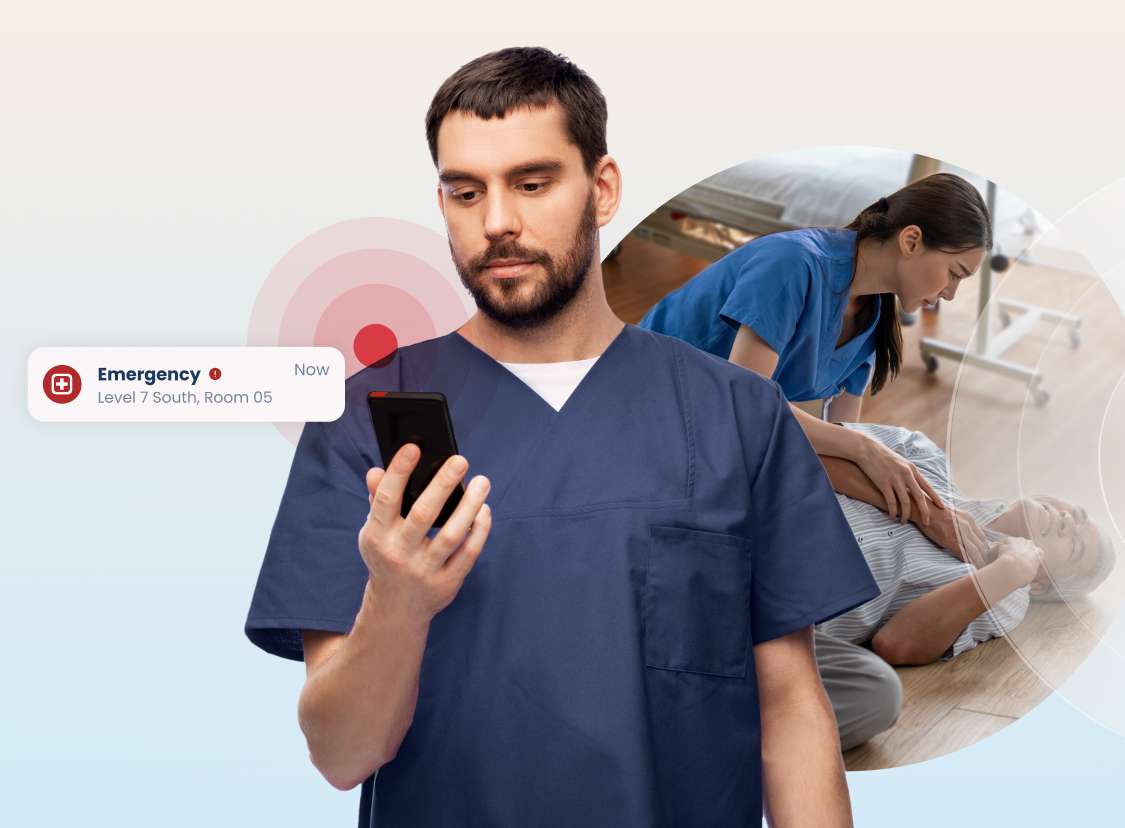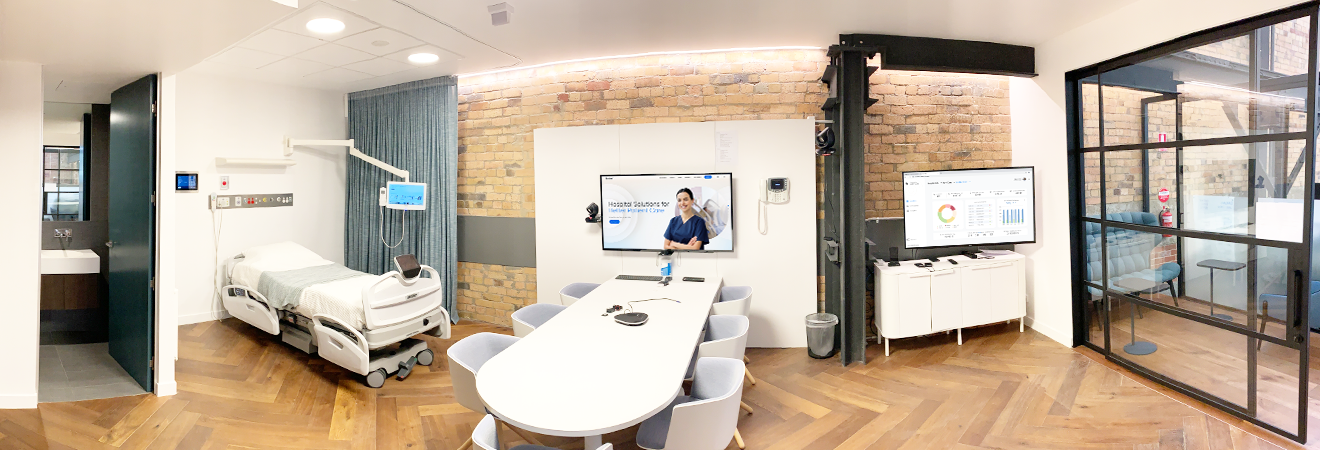- 5 min read
The Patient Room of the Future: Transforming Inpatient Care through Smart Technology
Hospital

Share:
In today’s hospitals, patient rooms often lack integration and personalisation, filled with disparate equipment and systems that don’t communicate with each other. As a result, these rooms remain generic, not tailored to the individual patient, their care needs, care team or family.
The digital patient room of the future aims to change this dynamic. By creating a unified, technology-driven space tailored to each patient, hospitals can leverage smart technology to enhance clinical outcomes, boost patient satisfaction and realise staff efficiency.
What a digital smart patient room entails
The patient room of the future is a highly integrated, digitally smart healthcare environment that is designed to achieve the following:
Seamless integration of patient data
All relevant patient information is seamlessly integrated across systems upon admission. Digital tools such as patient bed cards and patient flow journey boards update the patient details in real-time as they are entered into the EMR, ensuring authorised healthcare staff have instant access to up-to-date information —empowering them to make informed decisions at the point of care.
Unified communication
With unified communication platforms, patients, families and care teams are constantly connected. The room supports secure messaging, SIP calls and video calls, ensuring timely updates and collaboration across care teams. Notifications about patient arrival, updates or requests are sent directly to the mobile devices of assigned care team members, promoting a responsive, cohesive care experience.
Augmented reality and personalised patient interfaces
Personalised, accessible care is at the heart of the digital patient room. Augmented reality (AR) interfaces display relevant information tailored to each patient’s unique needs, such as meal choices based on dietary restrictions or educational content presented in the patient’s preferred language.
The system’s interfaces are adaptable, supporting voice commands for patients with mobility challenges or vision impairments, ensuring accessible healthcare for all and empowering patients in their care journey.
Providing care at the bedside
Staff can provide and document care at the point of care in the room. For example, any clinician who has access to the EMR can use their staff ID to tap on the bedside patient engagement and entertainment terminal and all the patient’s health information is automatically available at the point of care.
Personalised care automation
The digital room should include predictive safety features and smart, responsive features that can automatically trigger workflows based on individual patient information and predictive modelling.
For example, the room of a patient at high risk of falling triggers proactive safety workflows. The falls prevention and detection system is automatically armed to detect high-risk activities, e.g. a patient in the bathroom when no staff are present. The system sends an alert to the right nurse’s mobile device, enabling prompt support by the pre-assigned responsible staff member.
Advanced communication and task management
The smart digital room enables healthcare staff to personalise workflows and reminders, tailored to each patient. With automated task reminders and hourly rounding alerts sent to staff devices, clinical staff are better equipped to maintain efficient, personalised care schedules, empowering accountability and streamlining task management.
Robotics and automation
With integrating robotics and voice-activated systems, the digital room can respond to patient needs efficiently.
For instance, patients can request items such as blankets, through voice commands, and a robotic assistant bring those items to the room. This promotes patient autonomy and frees up staff time to focus on critical patient care tasks.
Empowering connectivity and telehealth
The digital patient room of the future reinforces social connectivity and wellbeing, allowing patients to easily communicate virtually with loved ones through the patient engagement and entertainment system.
Care teams can also conduct virtual rounding and involve external specialists for telehealth services or call interpreters as needed, providing inclusive, patient-centred care.
Next Steps
The digital patient room of the future harnesses technology to truly transform patient care that improves outcomes. It creates a space where personalisation, safety and efficient care converge to provide a supportive care environment for both patients and staff.
While these advancements might sound ambitious, much of this technology is already available. So, the question is: what’s preventing this future state from becoming a reality?
This topic was presented by the Rauland team as part of the Health, Innovation and Communication Conference (HIC). To learn how the patient room of the future can transform inpatient care at your facility, contact us today.
Share:
Related Content

- 24 February 2025
- 5 min read
Enhancing Staff Safety at Maitland Hospital with Mobile Duress
Discover how Maitland Hospital implements mobile duress technology to safeguard people safety in healthcare.
- Hospital

- 7 February 2025
- 5 min read
Effective Real-Time Location Systems (RTLS) in Healthcare: How to make the right choice for your facility’s needs
Understand the key considerations for healthcare decision makers when investing in RTLS-based digital health solutions.
- Enterprise
- Hospital
- Aged Care

- 6 January 2025
- 5 min read
Your Gateway to Better Care: Our Concentric Care platform in action
Our Experience Centre offers healthcare professionals a hands-on experience with our digital solutions that enhance patient care and transform healthcare delivery.
- Hospital
- Aged Care
- Rauland

- 24 February 2025
- 5 min read
Enhancing Staff Safety at Maitland Hospital with Mobile Duress
Discover how Maitland Hospital implements mobile duress technology to safeguard people safety in healthcare.
- Hospital

- 7 February 2025
- 5 min read
Effective Real-Time Location Systems (RTLS) in Healthcare: How to make the right choice for your facility’s needs
Understand the key considerations for healthcare decision makers when investing in RTLS-based digital health solutions.
- Enterprise
- Hospital
- Aged Care

- 6 January 2025
- 5 min read
Your Gateway to Better Care: Our Concentric Care platform in action
Our Experience Centre offers healthcare professionals a hands-on experience with our digital solutions that enhance patient care and transform healthcare delivery.
- Hospital
- Aged Care
- Rauland
